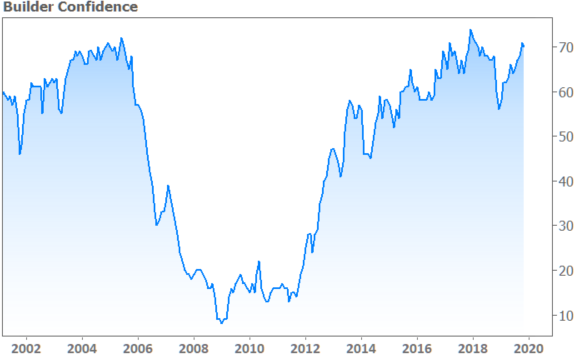Home builder confidence fell back slightly this month, declining by 1 point to 70 in the National Association of Home Builders (NAHB)/Wells Fargo Housing Market Index (HMI). The dip partially reversed the index's 3-point jump in October which had carried it to its highest reading since February 2018.
Derived from a monthly survey that NAHB has been conducting for 30 years, the NAHB/Wells Fargo Housing Market Index gauges builder perceptions of current single-family home sales and their expectations for sales over the next six months as "good," "fair" or "poor." The survey also asks builders to rate traffic of prospective buyers as "high to very high," "average" or "low to very low." Scores for each component are then used to calculate a seasonally adjusted index where any number over 50 indicates that more builders view conditions as good than poor.

The HMI index gauging current sales conditions fell two points to 76 and the measure charting traffic of prospective buyers dropped one point to 53. The component measuring sales expectations in the next six months rose one point to 77.
NAHB says single-family builders are currently reporting ongoing positive conditions, spurred in part by low mortgage rates and continued job growth. In a further sign of solid demand, this is the fourth consecutive month where at least half of all builders surveyed have reported positive buyer traffic conditions. The buyer traffic component of the survey has consistently lagged the other two components since well before the housing crisis, often by more than 20 points.
There has been substantial year-over-year improvement following the housing affordability crunch of late 2018, when the HMI stood at 60, NHBA says. "However, lot shortages remain a serious problem, particularly among custom builders. Builders also continue to grapple with other affordability headwinds, including a lack of labor and regulatory constraints."
Looking at the three-month moving averages for regional HMI scores, the Northeast posted a 2-point gain to 62, the West was up 3 points to 81 and the South moved one 1 higher to 74. The Midwest was unchanged at 58.







